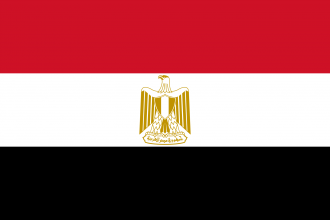The Arab Republic of Egypt (Egypt) is a Mediterranean country, located at the North-east corner of Africa. It borders with Libya to the west, Soudan to the south, and the Gaza strip and Israel to the east. Moreover, it is wet by the Mediterranean sea to the north and the Red sea to the east, as it stands at the crossroads of Europe, Africa and Asia. Cairo is the capital of Egypt and Alexandria is its second biggest city, both located at the northern part of the country.
The country is divided into 4 main areas; these include the Nile Valley & Delta, the Western Desert, the Eastern Desert and the Sinai Peninsula. The estimated more than 90 million inhabitants (2016) –Egypt is the most populous country in the Arab world- are mainly concentrated along the banks of the river Nile, in cities such as Cairo, Alexandria, Luxor, Port Sid and Aswan.
The regular floods of the river Nile, have helped the Egyptian territory, semi-isolated by deserts, to develop one of the greatest civilizations in human history. Furthermore, the completion of the Suez Canal - through which about 8% of global maritime shipping annually passes through-, introduced Egypt as an important transportation hub worldwide. In addition, the country’s strategic position, as a ‘controller’ of the Sinai Peninsula and the Suez Canal have established its central role in the MENA region.
In the last decades though, economic growth has been moderate, insufficient to absorb the rapidly growing labour force. Moreover, poverty has been persistently high and about 25% of population is unemployed, particularly women and young people. In 2011, following the Tunisian revolution, Egyptian demonstrations all over the country, led to President Mubarak fleeing the country. Egypt’s military assumed leadership, until the win of President Morsi in the 2012 elections. However, new protests –sometimes violent-, ousted Morsi in 2013, who was replaced by president Mansour. In May 2014, after a referendum, Abdel-Fattah Al-Sisi was elected as President, and a new legislature came into place, after 2015.
Since his election, Abdel-Fattah Al-Sisi, promised stability and economic reforms. However, imbalances still remain high in the region. Today, according to the Central Agency for Public Mobilisation and Statistics (CAPMAS), 27.8% of the population lives in poverty. Further, estimates indicate that more than 40% of the country’s wealth, is controlled by only 5% of the population.
Therefore, it is evident that despite the improvements in child mortality, life expectancy and literacy rates, significant structural reforms should further take place, in order to transform Egypt’s economy and reduce poverty; creation of new employment opportunities should not be underestimated, towards the preservation of political and social stability.

